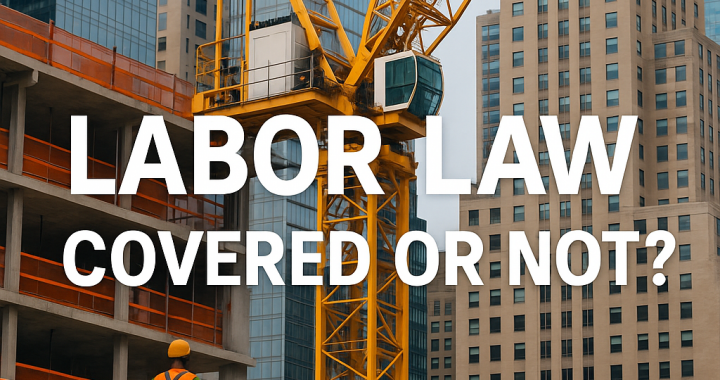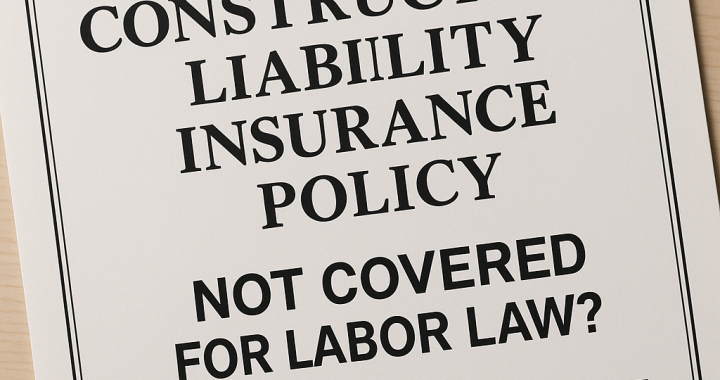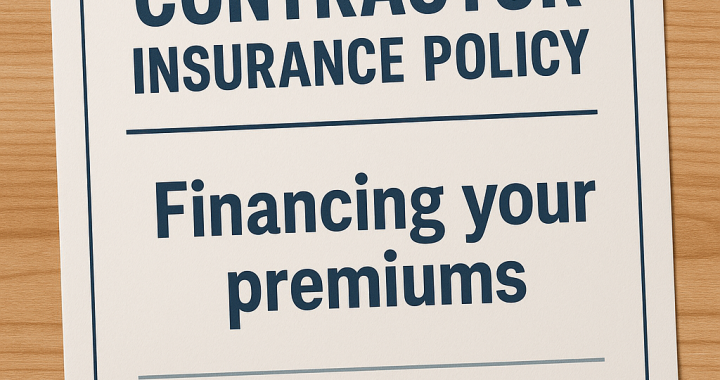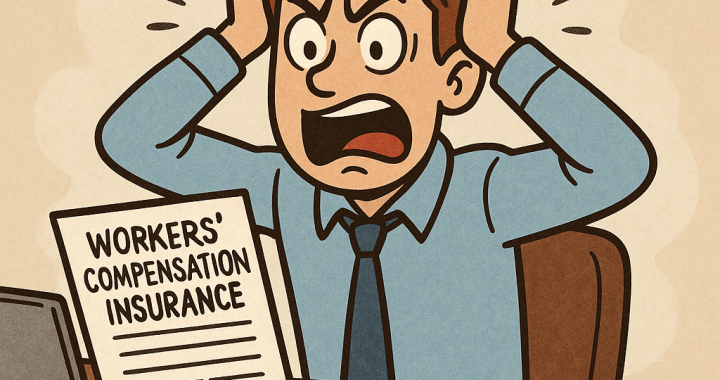Navigating the bustling construction industry in New York City requires not only skill but also the right protection. As a general contractor, securing insurance is crucial to safeguarding your projects against unexpected setbacks. But with so many options available, how do you choose the right policy? Here, we’ve compiled essential questions to help you make an informed decision when selecting general contractor insurance in NYC.1. What Types of Coverage Are Included?
As a general contractor, it’s important to recognize that coverage requirements can vary significantly. New York City, with its diverse projects ranging from residential to large-scale commercial real estate, necessitates comprehensive coverage that includes not just general liability but also nuances like workers’ compensation and property insurance. These are vital to protecting against bodily injuries on the job site, damages to structures, and even potential financial losses from legal claims. Without these types of insurance, contractors could face hefty lawsuits that might jeopardize the future of their business.
Beyond the basic types of coverage, specialized insurance such as professional liability for design errors or builder’s risk coverage for new constructions might also be necessary. The financial district of NYC, known for rapid development, often requires builder’s risk insurance to cover against theft, vandalism, and natural disasters during construction. Recognizing the specific needs based on project types will help in crafting a robust insurance policy that adequately covers potential risks.
2. How Much Coverage Do I Need?
Determining the amount of coverage can be tricky, especially in a high-stakes market like NYC. It’s crucial to evaluate the scale and scope of your projects. For instance, contractors working on skyscrapers versus smaller residential homes will have distinct needs. A larger project might require higher coverage limits to ensure all potential risks are mitigated effectively. Moreover, considering the urban environment of NYC, where building codes and risks are unique, contractors must align their insurance coverage to match the value and risk profile of their projects.
Additionally, it is wise to discuss with a broker who understands the intricacies of New York’s construction landscape. They can offer insights into historical claims and industry standards, helping you align your coverage needs with regulatory requirements and unexpected occurrences that larger cities face more frequently. Such an assessment ensures that your coverage is neither inadequate nor excessively costly. Taking these steps early—right from project planning—can prevent financial pitfalls later.
3. Are There Any Exclusions I Should Be Aware Of?
The last thing you want as a contractor is to discover that a key event isn’t covered. Policies often contain exclusions—specific scenarios or losses that won’t be reimbursed by the insurance policy—so understanding these beforehand is essential. Common exclusions might involve geotechnical problems or pollution incidents. Given New York’s stringent environmental regulations, not having pollution coverage could expose a contractor to significant risks and liabilities. A thorough review of policy exclusions, coupled with seeking expert advice where necessary, can prevent unexpected surprises when filing a claim.
4. Is the Insurer Familiar With NYC Regulations?
In a city that never sleeps, construction regulations and compliance issues are intricately woven into the fabric of operations. It’s not simply about meeting deadlines but also aligning with continually evolving zoning laws and building codes. Choosing an insurer with expertise in NYC regulations can make a world of difference. They can offer insight on coverage needs specific to local ordinances and potential legal changes that could impact your coverage requirements down the line. Such expertise ensures that you remain compliant and avoid potential fines or project shutdowns.
Additionally, insurers well-versed in NYC regulations can offer risk management advice tailored to city-specific scenarios, whether dealing with high-rise construction protocols or infrastructure projects requiring environmental compliance. With the right insurer, staying informed of these complexities becomes more straightforward, thereby safeguarding your business operations in a legal landscape that often presents formidable challenges.
5. How Are Claims Handled?
The claims process is a critical component of any insurance policy—it’s what you lean on when things go awry. A seamless, transparent process can make what could be a stressful situation much more manageable. Understanding how claims are handled involves looking into aspects like claim filing procedures, response times, and who will be handling your claims (e.g., in-house team vs. outsourced). Some insurers may offer streamlined digital claims processing, which can expedite payouts significantly—something particularly valuable for NYC contractors who need to minimize downtime between projects.
Furthermore, evaluating the insurer’s historical response to claims, perhaps through customer testimonials or industry ratings, can provide insight into their reliability during critical moments. No contractor wants to face delayed settlements due to inefficient bureaucracy. Opting for carriers with fast and efficient claims resolution is equally important, particularly in a fast-paced environment like New York City, where timelines play a crucial role in project success.
6. What Is the Policy’s Cost?
Budget concerns are central to every contractor’s business calculus, particularly when negotiating in NYC’s premium construction market. When discussing policy costs, it’s about understanding what you’re getting for your premium. Are there add-ons that inflate your costs without consequence? Are there areas where less coverage would suffice, potentially reducing your premium? A comprehensive policy doesn’t necessarily mean the costliest. Sometimes, insurers can offer competitive pricing whilst covering the essentials.
Interestingly, some policies might offer incentives for risk mitigation strategies, such as adopting enhanced safety protocols or having certified safety personnel on-site. Minimizing hazards can often lead to reduced premiums over time. Balancing between cost and coverage is key—it’s about leveraging savings without sacrificing essential coverage. In a dynamic city like NYC, this balance helps maintain a competitive edge while ensuring protection from potential liabilities.
7. Are Discounts or Bundles Available?
In the realm of contractor insurance, exploring discounts or bundled packages can result in significant savings. Insurers might offer special rates for bundling general liability and workers’ compensation, or discounts for contractors who implement robust safety training programs. For instance, reducing the frequency and severity of workplace incidents through comprehensive training can not only enhance safety but also reduce insurance premiums significantly. As construction sites in NYC are prone to various risks, investing in preventive measures can pay off in the long run.
Beyond discounts, insurers may have loyalty programs for long-term clients or offer reduced rates for those who demonstrate consistent safety improvements. Engaging with insurers to explore these options can be advantageous. Look for insurers that reward proactive management strategies—those that not only shield your enterprise today but fortify it for tomorrow’s challenges. Such financial incentives can bolster margins while maintaining optimal levels of protection.
8. Can the Policy Be Customized?
Customization in insurance allows contractors to tailor their protection in alignment with specific operational needs. In a city as diverse as New York, customization becomes crucial, given both the varied nature of projects and unique risks associated with certain types. Whether it’s increased coverage during intensive redevelopment phases or enhanced protection for high-value projects, having the ability to shift coverage terms enables contractors to maintain optimal protection against prevalent risks at any given stage.
Such flexibility can be essential, especially for contractors who frequently scale projects either from simple repairs to comprehensive high-rise constructions. Ensuring that your insurance can adjust accordingly minimizes the potential for coverage gaps. As projects evolve, so should the coverage terms. This adaptability not only safeguards your current operations but also assures stakeholders and clients of your professional integrity and commitment to risk management. Ultimately, a customizable policy affords the peace of mind that comes with knowing all aspects of your contracting business are adequately protected.
9. What Is the Insurer’s Reputation?
When choosing an insurer, it’s indispensable to evaluate their reputation. This means investigating their historical performance, client satisfaction ratings, and financial stability. For instance, references or third-party reviews might highlight an insurer’s reliability during challenging claim scenarios. An insurer with a solid track record is less likely to face difficulties in claim settlements or sudden changes in policy terms, which can jeopardize your financial stability when least expected.
Examining industry recognition and awards could also provide insight into their commitment to policyholder service, especially within NYC’s dynamic construction ecosystem. Verifying an insurer’s standing with agencies such as A.M. Best can yield another layer of confidence. Contractors should focus on carriers renowned for their unwavering support and transparent communication, values that become priceless during complex claims processes or when navigating legal intricacies inherent in New York City projects.
10. Is There a Deductible?
Deductibles—the portion you pay out of pocket before insurance coverage takes effect—are pivotal in structuring your budget and affecting your overall expenses. A lower deductible might mean higher premiums, but it also translates into less financial strain when a claim arises. Consider what deductible strategy aligns with your cash flow and risk appetite. In a volatile environment like NYC, where project costs can escalate unexpectedly, selecting the right deductible is a critical component of financial planning.
11. How Long Is the Policy Term?
Policy terms define the duration of coverage and renewal conditions. Understanding these terms is critical for anticipating future protection needs, particularly for multi-phase developments among NYC’s complex construction projects. Short-term policies might be ideal for short-term or time-bound projects, while long-term arrangements could offer stability for ongoing enterprises. Each requires careful evaluation of business objectives and timeline projections, which are crucial given NYC’s rapidly shifting market landscape.
12. What Is Covered Under General Liability?
General liability insurance encompasses numerous scenarios that might impact your project’s and clients’ safety. In NYC’s dense urban environment, protecting against liabilities such as property damage or third-party injuries is imperative. For example, if a passerby gets injured at your construction site or if equipment inadvertently damages neighboring properties, general liability would typically cover legal costs and damages. Understanding and delineating the extent of coverage can shield against longstanding legal disputes.
13. Does the Policy Include Coverage for Equipment?
Having the right coverage for your tools and machinery is indispensable, more so in a high-paced environment like New York. Given the reliance on advanced equipment for complex projects, ensuring that these assets are insured against damage, theft, or loss could potentially mitigate high replacement costs. Contractors heavily reliant on their gear to meet deadlines and maintain workforce productivity often consider equipment insurance a fundamental aspect of their overall risk management strategy.
14. What Are the Payment Options Available?
The availability of diverse payment options can ease cash flow constraints, a common challenge for contractors working within NYC’s competitive landscape. Insurers might offer installment plans, annual payments, or discounts for upfront full-term payments. Understanding how these can be structured to your benefit ensures that maintaining coverage aligns with predictable financial patterns, which is critical when projects of varying scopes overlap in tight schedules.
15. Can I Make Changes to the Policy as My Business Grows?
Growth is a key aspect of any thriving business, especially in an expanding market like NYC. Ensuring that your insurance allows for adjustments as your projects broaden in scope or evolve in nature is vital. Policies with flexibility foster confidence among investors and partners, reassuring them that all project elements are effectively covered. This adaptability, coupled with regular policy reviews, can optimize your insurance strategy amidst evolving business prospects.
BGES Group is one of New York, New Jersey, and Connecticut’s Construction Insurance Specialists representing 50+ companies, including all the BEST general & umbrella liability programs. We offer all the coverage needed, including property, builders’ risk, inland marine, general liability, umbrella liability, auto, bid & performance bonds, workers’ compensation, N.Y.S. disability, and group health. Our commitment to you goes beyond the policies we provide. We are always just a call, text, or email away, ready to assist you, even on weekends. We understand the importance of your business and are here to help you navigate any insurance challenges.
BGES Group are Workers’ Compensation Insurance Specialists for Tri-State Business Owners: Unhappy with your rates, company, being canceled, losses causing difficulty getting coverage, in the middle of an audit dispute, misclassified payrolls, or whatever your issue. We can help! We have special programs for Auto Services, Contractors (especially in New York), Limousine Services, Logistics Companies, Manufacturers, Recyclers, and Truckers; we can help ANY tri-state business owner. We are considered “Preferred Agents” for this one program that, if we can get you into, their pricing is excellent, offers long-term coverage stability, and can cover multi-state operations. The program takes the hassle out of doing annual audits, too.
If you want to speak with us, call Gary Wallach at 914-806-5853, click here to email, or visit our website.
Company: BGES Group, 216A Larchmont Acres West, Larchmont, NY 10538
email: bgesgroup@gmail.com
website: http://www.bgesgroup.com
© – Copyright – 2025 – BGES Group









